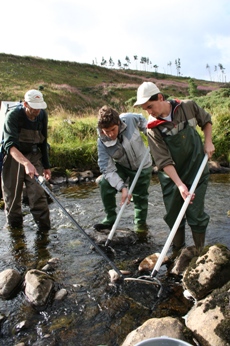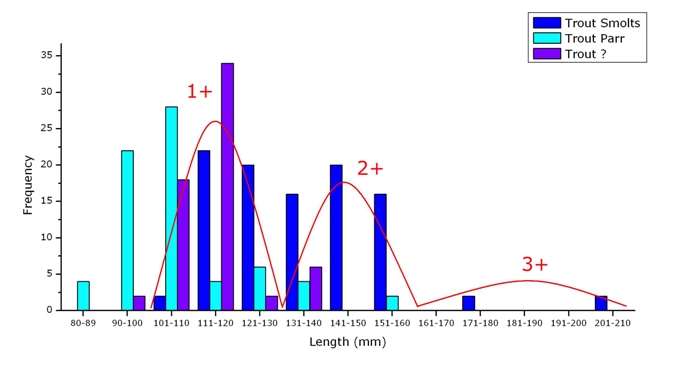|

Loch
Lomond and Trossachs National Park funds fish trap
A
new rotarty screw trap was deployed for the first time in spring
2008 in the river Endrick with funding from LLTNPA.
| |
 |
|
The
trap consists of a revolving drum driven by the flow of the
river and is used to trap salmon and trout smolts as the migrate
to the sea. The data collected provides valuable information
on the timing of migrations and population structure. The
graph to the right shows the length-age frequency of trout
captured during spring 2008 and indicates that sea trout smolt
migration takes place at three different ages. Over time,
the data will be used to estimate survival rates from fry
to smolt stages and to develop models to estimate total population
sizes for both salmon and sea trout in the Endrick catchment. |
Electro-fishing
surveys of juvenile salmonid abundance
A
detailed electro-fishing survey of the entire Endrick river catchment
was commenced in summer 2007 using a rapid semi-quantitative technique
to give a complete coverage of the accessible main-stem and major
tributaries.
 |
This
approach has provided a much more extensive picture of variations
in juvenile abundance and species distribution on a catchment
scale and has enabled the most productive nursery areas for
salmon and trout to be identified as well as those areas where
numbers are low. Combining this information with habitat data
allows the influence of physical habitat condition to be determined
and the extent to which areas with poor or degraded habitat
are limiting fish production. |
| The
map opposite shows relative abundance of age 0+ salmon fry
and indicates that much of the upper main river has healthy
natural production but this declines in the middle reaches
in part due to a lack of spawning gravel. The river Blane
(which is particularly important for sea trout production)
also has a significant salmon population but in other areas,
notably the Catter burn, salmon numbers appears to have crashed. |
 |
| In
order to improve natural recruitment, we need to understand
a rivers potential for production of juvenile fish and where
the bottlenecks to this production are. This is the primary
aim of the approach being taken by LLFT. Assisting natural
river recovery in areas where natural salmonid production
is potentially high is the sustainable way to conserve and
enhance these precious populations and must be at the core
of sound fishery management practices. |
|
|
Positioning
rotary screw in lower Endrick - Spring 2008
|



